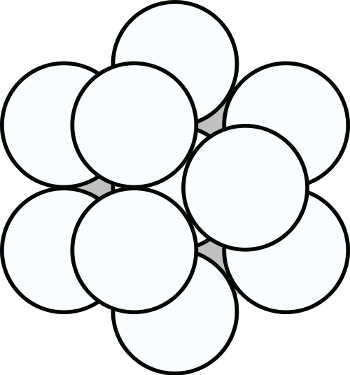Depletion Attraction
March 7, 2011
It's often instructive to think about the absence of things, rather than the things themselves. A
philosophical example of this, as attributed first to
Augustine, is the idea that evil, itself, does not exist. Evil is really the
absence of Good. In a more physical vein, we've discovered that cold is really the absence of
hot, and darkness is really the absence of
light. In
solid state physics, we have the idea of "
holes," the absence of
negative charge, as a
current carriers.
One interesting example of the use of absence in physics is the
steady state cosmology of
Fred Hoyle,
Thomas Gold and
Hermann Bondi. In an extreme appeal to the idea that
nature abhors a vacuum, the steady state theory proposes an idea of continuous creation of
matter. As the universe expands, matter is created to fill the voids. This proposal wasn't as extreme as it appears, since the amount of matter created would be just a single
hydrogen atom per
cubic meter per
billion years. However, the discovery of the
cosmic microwave background by
Penzias and
Wilson confirmed the
Big Bang theory, and few today believe in steady state cosmology.
Absence plays a role also in
solution chemistry. When we have particles in solution, it's obvious that two particles can't occupy the same space at the same time. This concept doesn't appear too enlightening until we see that in a mixture of large and small particles, one large particle can take the place of many smaller particles. This can be important when there are surface effects. For
spheres, the ratio of
surface area to
volume is a function of 1/r, where r is the sphere
radius, so a lot of small spheres filling the same volume as one larger sphere will have a larger surface area exposed to the solution.
One important observation on the differences between large and small particles in solution was published in 1958 by the
polymer scientists, Sho Asakura and Fumio Oosawa.[1] They found that there was an attraction between particles suspended in solutions that's not related to any specific force, such as
electrostatic attraction. The attractive force was found to be stronger in solutions of
macromolecules of
dissymmetrical shape.
Larger particles stick to each other, simply because the small particles that push them around in solution can't access the space between closely spaced large particles. Instead, the smaller particles have nothing else to do than to push the larger particles towards each other. It's a purely
thermodynamic effect. According to the Asakura-Oosawa model, the free energy change ΔF of the system that favors this process is given as[2]
ΔF ≈ n kB T [1 + 3/2(D/d)]
in which D and d are the
diameters of the larger and smaller spheres, T is
temperature, k
B is
Boltzmann's constant, and n is the
volume fraction of small spheres. Of course, (1-n) is the volume fraction of large spheres, and the spheres are considered to be
perfectly elastic. A more cogent summary of this effect, called depletion attraction, can be found in a paper about
cellular organization, reference two.[2]

An artful arrangement of spheres in space.
(Figure by
Jonas De Kooning,
from Wikimedia Commons).
A research group from the
New York University Department of Physics and
Center for soft Matter Research, led by Professor
Jasna Brujic, has utilized this depletion attraction effect as a way to improve
emulsions. Their model system was
oil droplets in water, which is a proxy for such things as
butter,
ice cream,
milk and various
lotions. Their object was to manipulate the way that the oil droplets pack, and thereby modify the material properties.[3]
Unlike the normal depletion attraction process, which is thermal, the colloidal process studied uses the
gravitational settling of the
colloids as the motive source for the particles. The oil particles in the colloids are large, so they added small
polymer particles. This addition affected the
jamming behavior of the particles, an effect seen in
granular media. This method has the potential of creating a spectrum of material properties from loose to dense. Their work is published in a recent issue of the
Proceedings of the National Academy of Sciences.[4]
References:
- Sho Asakura and Fumio Oosawa, "Interaction between particles suspended in solutions of macromolecules," Journal of Polymer Science, vol. 33, no. 126 (December, 1958), pp. 183-192.
- Davide Marenduzzo, Kieran Finan and Peter R. Cook, "The depletion attraction: an underappreciated force driving cellular organization," J Cell Biol., VOL. 175, NO. 5 (December 4, 2006), PP. 681-686
- James Devitt, "NYU Physicists Develop Potent Packing Process," NYU Press Release, February 28, 2011.
- Ivane Jorjadze, Lea-Laetitia Pontani, Katherine A. Newhall and Jasna Brujic, "Attractive emulsion droplets probe the phase diagram of jammed granular matter," Proceedings of the National Academy of Sciences, (Online, February 28, 2011).
- A. A. Louis, E. Allahyarov, H. Löwen and R. Roth, "Effective forces in colloidal mixtures: From depletion attraction to accumulation repulsion," Phys. Rev. E, vol. 65 (13 June 2002), Document 061407 (11 pages).
Permanent Link to this article
Linked Keywords: Philosophy; Augustine of Hippo; Privatio Boni; absence of Good; heat; light; solid state physics; electron holes; electric charge; negative charge; charge carrier; current carrier; steady state cosmology; Fred Hoyle; Thomas Gold; Hermann Bondi; Nature abhors a vacuum; matter; hydrogen; atom; cubic meter; age of the Earth; billion years; cosmic microwave background radiation; Arno Penzias; Robert Woodrow Wilson; Big Bang; solution chemistry; sphere; surface area; volume; radius; polymer science; Coulomb's law; electrostatic attraction; macromolecule; dissymmetrical; Thermodynamics; thermodynamic; diameter; temperature; Boltzmann constant; volume fraction; elastic collision; cell; Jonas De Kooning; Wikimedia Commons; New York University; Department of Physics; Center for soft Matter Research; Jasna Brujic; emulsion; oil; butter; ice cream; milk; lotion; gravitation; colloid; polymer; jamming; granular media; Proceedings of the National Academy of Sciences.